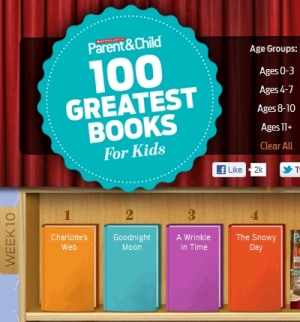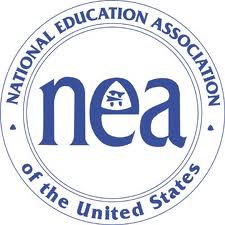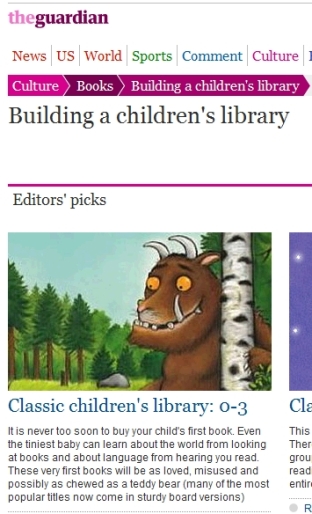I didn’t mean to be quite so critical of the Scholastic “100 Greatest Books for Kids” list in my last post. As someone who started a blog that’s all about recommending great children’s books to readers, I think I can understand the noble aspirations that are probably behind the creation of the list and I definitely can see how some people might find a “100 Greatest” list valuable. However, that being said, I still think the overly sensational presentation of the list robs it of a large portion of its inherent value. Yes, it’s great that some very educated, very passionate people assembled such a strong reading list, BUT I think their contributions are overshadowed by the over-the-top pomp and circumstance of suggesting that these 100 books hold more value than ANY other children’s titles. The “100 Greatest Books for Kids” opted for the inflammatory over the educational, and I think that was a bad call.
But that isn’t to say that “best book lists” are always a bad idea. They can be AMAZING, when they’re done right. So, in response to Scholastic’s “100 Greatest Books for Kids”, I thought I’d pass along five other examples of “Best Books for Kids” lists that (I think) present their recommendations in much more constructive and enlightening ways.
(I seriously debated calling this post “The FIVE Best Books for Kids Lists OF ALL TIME” – which probably would’ve done wonders for my SEO – but I wasn’t sure how obvious the sarcasm would be.)
1. National Education Association’s Kids’ Top 100 Books vs. Teachers’ Top 100 Books
In November of 1999, the National Education Association ran an online survey to see children and young adults would select as their top 100 favorite books– you can read the results here. While, like the Scholastic list, this is a “top 100” list, I like the NEA list because it’s clearly the result of a survey and, as such, saying that these picks were the “favorites” of the survey audience is a much less incendiary comment than saying that someone has identified the “100 greatest kids’ books EVER.” There are some weird picks and selections I don’t agree with, but I think it’s a fascinating document of what kids were reading at the time. (Also, since the survey took place in late 1999, don’t expect to see anything too recent on the list.)
The other great aspect of this list is that the NEA suggests that you cross-reference the list with a 2007 survey they did where teachers were asked to select their top 100 examples of quality literature for children – you can read that list here. There are some FANTASTIC suggestions on the teacher list – I prefer their picks to the kids’ list – and I think the teachers did a much better job of creating a balanced selection of new and iconic titles than the Scholastic list did. Granted, there is NO commentary to accompany these lists – it’s just a big dump of titles – but I think their selections and the perspective that they bring on their respective audiences make up for that shortcoming.
2. The Guardian’s “Building a Children’s Library” Recommended Reading List
I originally discovered the UK Guardian‘s “Building a Children’s Library” section online right after I registered the domain name for this site and was a few days away from launching it. Suffice to say, it caused me a very unpleasant afternoon filled with self-doubt and self-serving proclamations of “But it’s already been done before? WHY BOTHER?!” However, after browsing through the site for a few hours, I quickly realized that, while all about promoting the joys of reading, our sites had very different missions and voices. (At least that’s what I tell myself, so I can sleep at night… sob.)
The editorial team of the Guardian has done a blisteringly admirable job of putting together a primer for any parent looking to assemble a list of “classic” children’s titles for their kids. They break their recommendations into several different age groups – Classic children’s library: 0-3; Classic children’s library: 4-7; Books for tweens; and Teen library – and they provide some excellent and well-written commentary to accompany each title. More than any other “best books” list I’ve found online, the Guardian‘s recommendations do an amazing job of providing context for each title and really giving a nice, concise argument of WHY this title is perfect for its age group. (They also pick many wonderful-sounding UK titles that might not be familiar to US audiences – that’s another plus in my column.) One warning: The Guardian’s “Building a Children’s Library” site seemingly hasn’t been updated since around 2005 – and some lists date back to 2000 – which is a shame.
And, I’ll admit, I have a big crush on the Guardian‘s “About the Library” summary where, in a few paragraphs, they completely reject the sensational posturing of the Scholastic “100 Greatest List” and rather revel in how subjective, personal, and human their recommendations are. Here’s an excerpt:
This list is not intended to be definitive. It is merely a jumping-off point, a place to start exploring the world of books. In recent years publishing for children has become a growth area. The shelves of bookshops – but not, alas, our cash-starved libraries – are stuffed with new titles and classics. Where to begin? How to choose? We hope that this list will help you and your children and teenagers plunge in and develop your own taste and own likes and dislikes. … [read the rest of the post…]
{ 2 comments }


